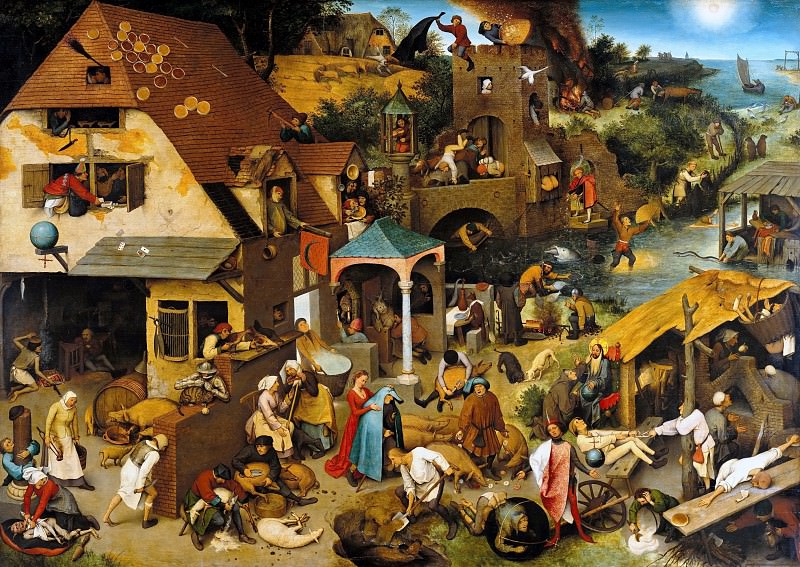The Dutch Proverbs Pieter Brueghel The Elder (1525-1569)
Pieter Brueghel The Elder – The Dutch Proverbs
Edit attribution
Download full size: 5200×3682 px (8,2 Mb)
Painter: Pieter Brueghel The Elder
Location: Berlin State Museums (Staatliche Museen zu Berlin), Berlin.
Bruegel’s painting "Dutch Proverbs" contains over a hundred proverbs, many of which have never been solved, and some of which are still used in our lives today. Art historians are still engaged in the identification of many proverbs, and more than a hundred proverbs and winged expressions have already been found in the picture. We see in the center of the painting a prominent arbor in which a man is confessing to the devil.
Description of Peter Bruegel the Elder’s painting Dutch Proverbs
Bruegel’s painting "Dutch Proverbs" contains over a hundred proverbs, many of which have never been solved, and some of which are still used in our lives today.
Art historians are still engaged in the identification of many proverbs, and more than a hundred proverbs and winged expressions have already been found in the picture. We see in the center of the painting a prominent arbor in which a man is confessing to the devil. At the same time, a monk nearby is mocking Jesus Christ with an artificial beard. The pie-covered roof is an illustration of the winged "Fool’s Paradise," and the absence of a piece of shingles on it is a kind of prototype of the modern "the walls have ears."
The man in the tower is doing aimless work-"throwing feathers in the wind"-and his mate is "keeping his cloak in the wind," that is, adjusting his beliefs to the circumstances. The woman gazing at the stork is practically "counting crows." Many more interesting characters in the painting: and the girl who swaddles the devil with a pillow, the girl carries a smoking head and a bucket of water, another - puts the horns on her husband, or rather covers him with a blue cloak, one man tries to open his mouth wider than a pipe, that is overestimate their capabilities ... And many, many others, corresponding proverbs, phrases and expressions.
In general, the goal of the author of the painting was not just to collect a lot of proverbs on one canvas, but also to condemn stupidity, destruction, immorality. Most proverbs mock or reproach people with various vices: gluttony, avarice, lust, pride, etc. This whole folkloric panorama is a skeptical critique of the artist’s contemporaries, which is not imposed on the viewer, but is demonstrated in the actions of the people in the picture, most often quite ridiculous, along with the ordinary villagers.
To give a final sense of how exaggerated and yet close to reality the composition is, the author draws an ordinary globe, but upside down, symbolizing the inversion of the world and the onset of chaos on the basis of what has already succeeded in shaking the normal life.
In this way, Bruegel conveyed in his painting a multiplicity of folklore and also expressed his discontent, denouncing in as graphic a manner as possible many of the vices and problems of the time.
Кому понравилось
Пожалуйста, подождите
На эту операцию может потребоваться несколько секунд.
Информация появится в новом окне,
если открытие новых окон не запрещено в настройках вашего браузера.
You need to login
Для работы с коллекциями – пожалуйста, войдите в аккаунт (open in new window).




















COMMENTS: 3 Ответы
http://sr.gallerix.ru/1029566649/B/1838043381/хорошее фото
Картина еще большая загадка, чем Мона Лиза
Была в музее, видела эту работу, в восторге!
You cannot comment Why?
On the left, a house features round gold coins on its roof, possibly representing the proverb money falls from the sky or hoarder of wealth. People are seen looking out of windows, some engaging in what appears to be gambling, with cards scattered on the ground. A man is shown thrusting his head through a window, perhaps to catch something falling, or to be seen as foolishly simple.
In the center, a woman in a blue dress drapes a cloak over a man who pokes his head through it, a visual representation of to blind someone. Nearby, figures are busy with various tasks, including playing music and attending to pigs. A prominent scene depicts a man trying to catch a bird by its leg, symbolizing to catch a bird in the egg or the futility of trying to secure something before its certain.
The castle-like structure has figures at various levels. On its highest point, a man is shown falling headfirst from the battlement, likely illustrating to fall from grace or to be a fool who acts rashly. Other figures are wrestling or pushing each other around the structure.
To the right, the river is a focal point with many actions. One man is attempting to swim against the current, possibly symbolizing the struggle against overwhelming odds. Another figure appears to be trying to catch fish with his bare hands. A blacksmith is seen working at a forge, and nearby, a man sits with a book, possibly representing scholarship or contemplation amidst the chaos.
One of the most striking scenes is in the lower right, where a man is lying on a plank, being pulled by another man drawing a cart, illustrating the proverb pulling the leg or perhaps to be deceived. Another figure is lying face down in a trough, while others are engaged in tasks that seem nonsensical or dangerous.
The overall subtext of The Dutch Proverbs is a critical and often humorous commentary on human folly, greed, and the absurdities of daily life. Bruegel showcases the human condition through a dense tapestry of proverbs, many of which highlight the foolishness of man in his pursuit of wealth, status, and pleasure, often at the expense of his own well-being or common sense. The painting is a rich, allegorical work that invites viewers to decipher its multitude of meanings and reflect on the timeless nature of human behavior.